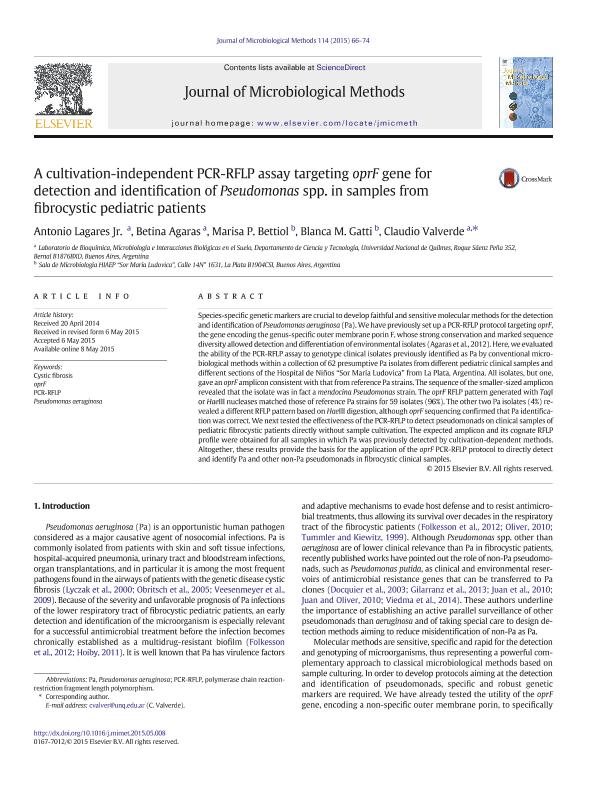Mostrar el registro sencillo del ítem
dc.contributor.author
Lagares, Antonio

dc.contributor.author
Agaras, Betina Cecilia

dc.contributor.author
Bettiol, Marisa
dc.contributor.author
Gatti, Blanca
dc.contributor.author
Valverde, Claudio Fabián

dc.date.available
2018-04-16T16:23:24Z
dc.date.issued
2015-05
dc.identifier.citation
Lagares, Antonio; Agaras, Betina Cecilia; Bettiol, Marisa; Gatti, Blanca; Valverde, Claudio Fabián; A cultivation-independent PCR-RFLP assay targeting oprF gene for detection and identification of Pseudomonas spp. in samples from fibrocystic paediatric patients; Elsevier Science; Journal of Microbiological Methods; 114; 5-2015; 66-74
dc.identifier.issn
0167-7012
dc.identifier.uri
http://hdl.handle.net/11336/42125
dc.description.abstract
Species-specific genetic markers are crucial to develop faithful and sensitive molecular methods for the detection and identification of Pseudomonas aeruginosa (Pa). We have previously set up a PCR-RFLP protocol targeting oprF, the gene encoding the genus-specific outer membrane porin F, whose strong conservation and marked sequence diversity allowed detection and differentiation of environmental isolates (Agaras et al., 2012). Here, we evaluated the ability of the PCR-RFLP assay to genotype clinical isolates previously identified as Pa by conventional microbiological methods within a collection of 62 presumptive Pa isolates from different paediatric clinical samples and different sections of the Hospital de Niños ?Sor María Ludovica? from La Plata, Argentina. All isolates, but one, gave an oprF amplicon consistent with that from reference Pa strains. The sequence of the smaller-sized amplicon revealed that the isolate was in fact a P. mendocina strain. The oprF RFLP pattern generated with TaqI or HaeIII nucleases matched those of reference Pa strains for 59 isolates (96%). The other two Pa isolates (4%) revealed a different RFLP pattern based on HaeIII digestion, although oprF sequencing confirmed that Pa identification was correct. We next tested the effectiveness of the PCR-RFLP to detect pseudomonads on clinical samples of paediatric fibrocystic patients directly without sample cultivation. The expected amplicon and its cognate RFLP profile were obtained for all samples in which Pa was previously detected by cultivation-dependent methods. Altogether, these results provide the basis for the application of the oprF PCR-RFLP protocol to directly detect and identify Pa and other non-Pa pseudomonads in fibrocystic clinical samples.
dc.format
application/pdf
dc.language.iso
eng
dc.publisher
Elsevier Science

dc.rights
info:eu-repo/semantics/openAccess
dc.rights.uri
https://creativecommons.org/licenses/by-nc-sa/2.5/ar/
dc.subject
Cystic Fibrosis
dc.subject
Oprf
dc.subject
Pcr-Rflp
dc.subject
Pseudomonas Aeruginosa
dc.subject.classification
Otras Ciencias Biológicas

dc.subject.classification
Ciencias Biológicas

dc.subject.classification
CIENCIAS NATURALES Y EXACTAS

dc.subject.classification
Otras Ciencias Biológicas

dc.subject.classification
Ciencias Biológicas

dc.subject.classification
CIENCIAS NATURALES Y EXACTAS

dc.title
A cultivation-independent PCR-RFLP assay targeting oprF gene for detection and identification of Pseudomonas spp. in samples from fibrocystic paediatric patients
dc.type
info:eu-repo/semantics/article
dc.type
info:ar-repo/semantics/artículo
dc.type
info:eu-repo/semantics/publishedVersion
dc.date.updated
2018-04-10T17:52:35Z
dc.journal.volume
114
dc.journal.pagination
66-74
dc.journal.pais
Países Bajos

dc.journal.ciudad
Amsterdam
dc.description.fil
Fil: Lagares, Antonio. Consejo Nacional de Investigaciones Científicas y Técnicas; Argentina. Universidad Nacional de Quilmes. Departamento de Ciencia y Tecnología; Argentina
dc.description.fil
Fil: Agaras, Betina Cecilia. Consejo Nacional de Investigaciones Científicas y Técnicas; Argentina. Universidad Nacional de Quilmes. Departamento de Ciencia y Tecnología; Argentina
dc.description.fil
Fil: Bettiol, Marisa. Sala de Microbiología HIAEP “Sor María Ludovica”; Argentina
dc.description.fil
Fil: Gatti, Blanca. Sala de Microbiología HIAEP “Sor María Ludovica”; Argentina
dc.description.fil
Fil: Valverde, Claudio Fabián. Consejo Nacional de Investigaciones Científicas y Técnicas; Argentina. Universidad Nacional de Quilmes. Departamento de Ciencia y Tecnología; Argentina
dc.journal.title
Journal of Microbiological Methods

dc.relation.alternativeid
info:eu-repo/semantics/altIdentifier/doi/http://dx.doi.org/10.1016/j.mimet.2015.05.008
dc.relation.alternativeid
info:eu-repo/semantics/altIdentifier/url/https://linkinghub.elsevier.com/retrieve/pii/S0167701215001475
Archivos asociados
